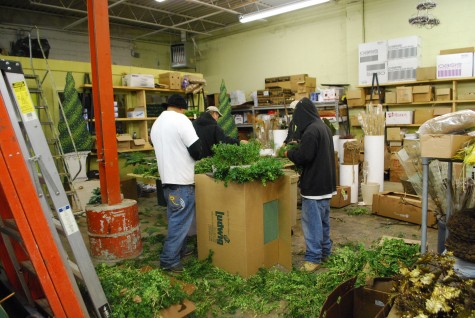 A good client whom I really like from Ypsilanti drove up this afternoon with his Mom. He was after materials for both of their winter pots. In the course of our conversation he told me he not only liked reading Dirt Simple, he was surprised and appreciative that I explain how I do things. No doubt how I do things is based on many years of experience with what does not work so well, interspersed now and then with a few good ideas. My thought process, my construction process-I have no reason not to share that. Should anyone decide to take on assembling their own winter pots based on my advice-this makes me feel like a useful human being. Most people share and teach at one time or another in their lives-their kids, their friends, their family-doing this means something. It means something to me too, and it feels great. Gardening is a messy, dirty, exhausting business; should you be game, I am more than happy to coach.
A good client whom I really like from Ypsilanti drove up this afternoon with his Mom. He was after materials for both of their winter pots. In the course of our conversation he told me he not only liked reading Dirt Simple, he was surprised and appreciative that I explain how I do things. No doubt how I do things is based on many years of experience with what does not work so well, interspersed now and then with a few good ideas. My thought process, my construction process-I have no reason not to share that. Should anyone decide to take on assembling their own winter pots based on my advice-this makes me feel like a useful human being. Most people share and teach at one time or another in their lives-their kids, their friends, their family-doing this means something. It means something to me too, and it feels great. Gardening is a messy, dirty, exhausting business; should you be game, I am more than happy to coach.
 I like selecting a palette of materials with a client. We have a discussion-a relationship. A little bit of me, and a lot of them makes for a good cocktail. Whatever I have inside that prompts me to suggest putting this with that-I am happy to share that. Having a shop full of possibilities makes the process fun.
I like selecting a palette of materials with a client. We have a discussion-a relationship. A little bit of me, and a lot of them makes for a good cocktail. Whatever I have inside that prompts me to suggest putting this with that-I am happy to share that. Having a shop full of possibilities makes the process fun.
 The reality of beautifully constructed winter containers can be daunting. To follow are the facts. I construct everything in my studio-garage; putting an arrangement together on site in freezing temperatures and late fall winds is tough to do promptly, and impossible to clean. The mess of the green discards is enormous. We have giant surfaces set up for the season to hold all the materials; the concrete floor obligingly holds no end of trash-it can be knee deep by the end of the day.
The reality of beautifully constructed winter containers can be daunting. To follow are the facts. I construct everything in my studio-garage; putting an arrangement together on site in freezing temperatures and late fall winds is tough to do promptly, and impossible to clean. The mess of the green discards is enormous. We have giant surfaces set up for the season to hold all the materials; the concrete floor obligingly holds no end of trash-it can be knee deep by the end of the day.
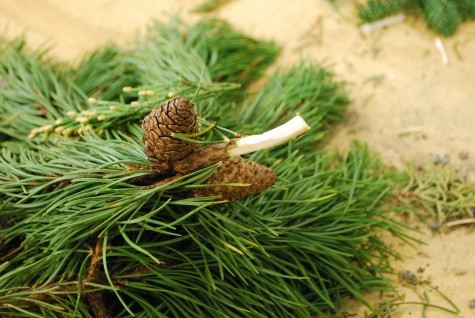 We whittle down every evergreen stem. This takes lots of time and effort. The big idea here? The above ground representation is vastly more showy than the below ground anchoring. How we anchor, and prepare a winter pot to last the six months until April requires what I would call work. For a tight fit, we sharpen the stems.
We whittle down every evergreen stem. This takes lots of time and effort. The big idea here? The above ground representation is vastly more showy than the below ground anchoring. How we anchor, and prepare a winter pot to last the six months until April requires what I would call work. For a tight fit, we sharpen the stems.
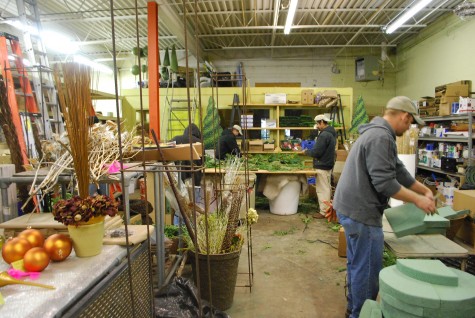 Everyone on my crews has a job. Forms, centerpiece construction, the stuffing of the greens-my two crews are 8 people. They produce work astonishingly fast. They spend a lot of time planting shrubs; this knowledge furnishes their construction with cut greens with a finished product that looks natural and believable.
Everyone on my crews has a job. Forms, centerpiece construction, the stuffing of the greens-my two crews are 8 people. They produce work astonishingly fast. They spend a lot of time planting shrubs; this knowledge furnishes their construction with cut greens with a finished product that looks natural and believable.
 This mixed evergreen winter blanket destined to warm a large round pot-It is beautiful, is it not? Should you have a mind to do it yourself, we observe these gweneral rules. We buy greens that are boughs, not the short pieces that are great for holiday floral arrangements. We aim for a low and wide overall shape-the greens are anywhere from 8-16 wider than the container all the way around. We green the edges of the form first, and work towards the center.
This mixed evergreen winter blanket destined to warm a large round pot-It is beautiful, is it not? Should you have a mind to do it yourself, we observe these gweneral rules. We buy greens that are boughs, not the short pieces that are great for holiday floral arrangements. We aim for a low and wide overall shape-the greens are anywhere from 8-16 wider than the container all the way around. We green the edges of the form first, and work towards the center.
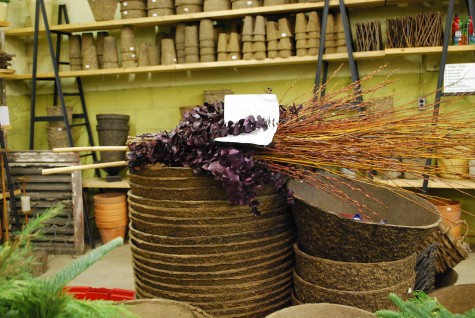 Materials chosen for a centerpiece-our process is to collect materials, and tag them with a name. The amounts needed for each element is based not only on the size, but the location of the container.
Materials chosen for a centerpiece-our process is to collect materials, and tag them with a name. The amounts needed for each element is based not only on the size, but the location of the container.
 The actual construction involves the numbers of bunches, the placement of picks, the overall shape. Relevant to the construction- great evergreen material, concrete wire, bamboo stakes, big zip ties, mini zip ties, foam forms. A conterpiece of this size has a stout bamboo stake which goes deep into the container. Additional anchoring with bamboo or steel is done during the installation.
The actual construction involves the numbers of bunches, the placement of picks, the overall shape. Relevant to the construction- great evergreen material, concrete wire, bamboo stakes, big zip ties, mini zip ties, foam forms. A conterpiece of this size has a stout bamboo stake which goes deep into the container. Additional anchoring with bamboo or steel is done during the installation.
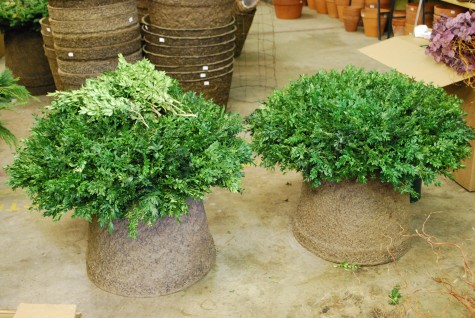
These boxwood sculptures have a lush look. Once they are dropped into their winter pots, there will be not hint of all the mess and hard work-just a graceful reminder of the garden that will be handsome to look at during the winter months.
What an amazing process. Are you using the dry floral foam for your bases? Your winter pots are stunning! Thanks and I agree with your above reader, it’s like taking a horticulture/creativity class online. Thanks
Dear Mary, I do use dry floral foam-it gives me the freedom to stick stems any which way I want-as opposed to always straight down into the dirt. Deborah
I too enjoy reading your site and I check in everyday. So glad you are willing to teach us how you make some of those beautiful winter pots. Thanks so much.
I find it interesting how you do your pots. I never thought to whittle the stems or to use bamboo stems. Thanks for sharing your methods! I would love to see more of your winter containers.
I absolutely love your designs! How do you anchor the foam base with the greens to the pots? I am one of those that goes out in the cold to arrange winter pots and am so glad to consider an alternative 🙂 We have lots of wind in the cold Idaho winters so securing everything properly is a major problem. Thanks so much for sharing your work!
Dear Lisa, We do a double layer of foam (glued together)-and set the form that is already stuffed right on top of the soil in the pot-we may take the soil down 4 inches or so. If its a windy site, drive bamboo stakes through the foam and down into the soil in 3 or 4 places. A tall centerpeiece should have its own stake. Deborah
DS is a regular stop on my daily blog tour. I always look forward to see what you’re sharing with us next. Thank you!
I have a question for you. You stated the winter pots will last until April. If the evergreen boughs and boxwood are live, why don’t the needles and leaves drop off before April? Love your winter pots. Wish I lived closer as I would love to visit your shop.
Dear Gayle, I do not know why. I do know that an evergreen that dies in the landscape will be green a very long time before the needles brown. If you have a dead spruce in your yard, chances are it died months previous. Christmas trees are cut months head of the holiday season. Boxwood leaves will turn brown-and still hold on. If you cut willow branches before they naturally shed-they will not shed-you have to pull the leaves off by hand. The process of dehiscing-or letting go of leaves-I don’t know that much about the science of it.